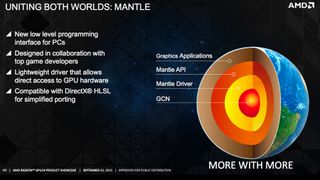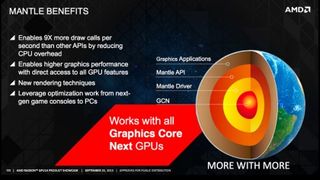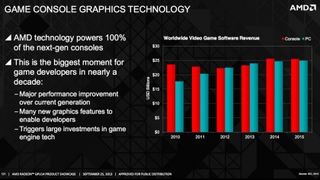AMD Mantle: what you need to know
Digging deeper into what Mantle means for PC games

Console gaming is about to get a major upgrade by way of Xbox One and PS4 being outfitted with next-generation AMD CPU and GPU technology.
However, the Sunnyvale, Calif.-based semiconductor company is also promising to change the often-overshadowed PC gaming market with its new AMD Mantle specification.
This forthcoming low-level graphics API aims to solve some of the major hurdles that developers within the video game industry have long had with DirectX and OpenGL.
The result for the end-user is quite simple: richer-looking games with far better performance and fewer excruciating wait times while console-to-PC ports take place.
What is AMD Mantle?
AMD Mantle is a new low-level application programming interface built for AMD's Graphics Core Next architecture, replacing high-level alternatives that failed to use all CPU cores.
Mantle, in this way, is catching up to console programming models by offering developers the ability to fully harness multi-core graphics hardware capabilities for the first time.
It also benefits from improved CPU and GPU collaboration, something that was barely possible before and has been a long-held request by PC game developers.
Get daily insight, inspiration and deals in your inbox
Get the hottest deals available in your inbox plus news, reviews, opinion, analysis and more from the TechRadar team.
"It's no big secret that [console maker's] programming models have always taken a very similar approach," Ritche Corpus, AMD's Director of ISV Gaming and Alliances, told TechRadar.
"They're always trying to give them as close enough access to the metal to maximize performance."
Mantle is able to do just that, but on a different scale by utilizing the more powerful PC hardware that's out there.

Mantle to make development easier
Mantle is the software and Graphics Core Next is the hardware solution to unifying the console ecosystem and much of the PC market under common graphics architecture.
"[It allows] developers to uniformly work across multiple platforms in a single endeavor—consoles and PCs may be treated equitably," wrote Corpus in an official blog post Oct. 17.
That's great news for the top game developers, like Swedish studio EA DICE, which AMD said it collaborated with in designing the new low-level API.
The Battlefield 4 developer, the first Mantle partner to be announced, can work across five different platforms with common architecture and familiarity.
That is certainly going to cut down on the cost and overhead.
Speaking of overhead, one of the Mantle benefits is that it enables 9 times more draw cells per second than other APIs by reducing CPU overhead and bottlenecking.
More developers have signed on to take advantage of these features, including Cloud Imperium Games, Oxide Games and most notably Deus Ex: Human Revolution developer Eidos-Montreal.
"Mantle lets you use AMD Radeon GPUs the way they are meant to be used, unlocking many new opportunities and increased CPU and GPU performance," wrote David Anfossi, Eidos-Montreal studio head, in a press release.
"Because of this, Mantle is one of the most important changes to PC graphics in many years."
What that means for gamers
Cutting through the technical jargon, Mantle is going to see games with improved graphics fidelity and that push the frame rate further, all of which could lead to faster development times.
"It opens up the opportunity for these game developers to give them more options to bring more realism," Corpus told us.
"If you understand how game development goes, it really is a balancing act of performance and graphics fidelity. The targeted end result is to bring as much realism to the gameplay and to the end-user experience."
Corpus noted that Mantle performance optimizations are going to allow developers to bring new features like its groundbreaking TressFX Hair technology that has been held back by older hardware out there.
"The added performance potential of Mantle, limitations that used to prevent us from utilizing things like TressFX will be removed and allow us to add potentially new features."

Port authority
One of the final benefits that AMD laid out in its Mantle presentation at AMD Hawaii was that the API can leverage optimization work from next-gen game consoles to PCs.
Because Graphics Core Next has been around for a few years, game developed already know what to expect from the Mante's GCN-based architecture.
"That means it will allow those same developers to utilize that knowledge gained and leverage that to shorten the learning curve and development cycle," said Corpus.
"The experience of developing on Mantle of GCN arch could help improve and speed up the ports that are happening between consoles and the PC."
Faster porting times, lower development costs, and the ability to work on other pressing issues is all going to benefit the end user when a game comes out.

Only the crust of Mantle
AMD is only through the crust of what Mantle has to offer. It's promising new feature and more game announcements at its AMD Developer Summit 2013.
That's when you'll hear about more games and game developers supporting Mantle with flashy demos and hear about AMD's TrueAudio technology for GPUs.
There are also going to be more technical talks with Mantle architects architects who will offer deep dives into the lower-level API's innerworkings.
That happens starting in San Jose starting this week, ensuring that the month isn't completely dominated by next-generation console gaming.
Most Popular



